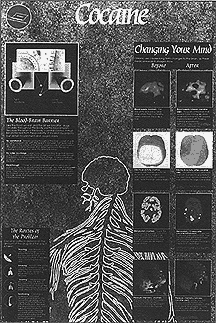A NIDA-funded multimedia education project designed to show adults, teenagers, and even elementary school children how drugs affect the brain is on display at the Museum of Science in Boston. Titled "Changing Your Mind: Drugs in the Brain," the project's intent is to teach the public how drugs of abuse affect the brain and to promote prevention of substance abuse. The education project includes an interactive computer-based software program that allows users to see animated depictions of drugs working in the brain, a museum exhibit, and a play in which a college professor and a student learn how little they know about how drugs work and their own drug use problems.
The computer program has been pressed into a CD-ROM to provide advanced technology on a compact disk featuring movies, animation, and sound. Developed by Dr. Bertha K. Madras and Dr. Luke Sato, it allows a user to sit at a personal computer and select options that include interviews and profiles of typical drug users, dramatizations of how each drug of abuse works, and explanations of drug abuse risks, addiction, and recovery. "Without too many words, it demonstrates complex neurobiological concepts very easily," says Dr. Madras, project director and an associate professor at Harvard Medical School.
 Walk-by display panels depict how drugs work.
Walk-by display panels depict how drugs work.
"One of the concepts it illustrates is that drugs are chemical impostors that enter the communication system of the brain. With animation, we show that nerve cells talk to one another by squirting out signals in the form of chemical messengers. We show that drugs act as impostors, fooling the brain by acting on the same targets in the brain as the 's own chemical messengers." The animated chemical models were designed by Dr. Wayne Mascarella at Research Triangle Institute in North Carolina.
The computer program is interactive, meaning the user responds to questions and menu options on the computer screen to select the information he or she wants to receive. The program is very popular, particularly with students who see it as exciting and challenging, according to Dr. Madras. When the program was demonstrated at the annual meetings of the Society for Neuroscience and the College on Problems of Drug Dependence in 1994 and 1995, visitors lined up, eager to use it. Medical students and faculty members, as well as high school teachers and students, were captivated by the computer display and asked how they could obtain copies of the program.
The goal is to mass produce the CD-ROM and to make it widely available as an educational tool for high school science classes and other interested groups. The CD-ROM program holds great potential as a teaching tool, according to Dr. Cathrine A. Sasek of NIDA's Office of Science Policy and Communications. Since the interactive nature of the presentation is appealing to students, a special version along with an accompanying curriculum and print materials may initially be developed for high school students, she says.
The walk-by museum display consists of eight freestanding exhibition kiosks presenting information on drug distribution in the brain and how drugs act at targeted sites. The exhibit allows visitors to view at a microscopic level how drugs lodge in the same regions of the brain that certain natural brain chemicals do. The exhibit also demonstrates similarities between structures of the brain's natural chemicals and drugs of abuse. These similarities enable the drugs to produce exaggerated responses and, for some users, induce addictive behavior. The risk factors and unpredictable effects of drug use are highlighted as well.
The exhibit also provides detailed descriptions of the actions of individual drugs including tobacco, alcohol, narcotics, cocaine, marijuana, hallucinogens, anabolic steroids, and therapeutic drugs such as antipsychotics and antidepressants. Also featured is cultural and historical information about drugs of abuse. Another segment shows how drug-abusing pregnant women put their babies at risk and the relationship between drug abuse and AIDS.
"There's a lot of interest in the exhibit display," says Dr. Madras. "I notice high school students reading the text closely and some taking notes." After the exhibition at the Boston museum ends, plans call for the project to be displayed at selected museums around the country.
The project's half-hour play was performed at the museum three times each Saturday and Sunday for audiences of up to 100. The play featured two drug users: a female college professor who smokes and drinks to excess and who has experimented with other drugs and a young male minority college student who is experimenting with drugs, although he has no intention of becoming addicted. Neither understands the risks of addiction. "Both are in denial with regard to their personal risks associated with drug use," explains Dr. Madras.
The two characters, played by professional actors, fall asleep and dream. They and the audience see - via theatrical tricks and slides - how cocaine, LSD, and marijuana resemble the brain's own chemicals; a portrayal of the role of the neurotransmitter dopamine in the brain; and the long-term effects of cocaine. When they awake, the pair reflect on whether their new knowledge of drugs will make a personal difference.
During the play, audience members are asked to explain why they think people take drugs and whether drugs change the brain. In response, "young students say things like, 'People take drugs to forget their troubles or because friends push them to.' You get some fascinating theories," says Dr. Madras.
The project is being funded through a NIDA Science Education Drug Abuse Partnership Award. Additional funding comes from the Dana Alliance for Brain Initiatives and the Harvard Mahoney Neuroscience Institute. The project is the product of a partnership between the Museum of Science, the Division on Addictions at Harvard Medical School, and the Society for Neuroscience.
